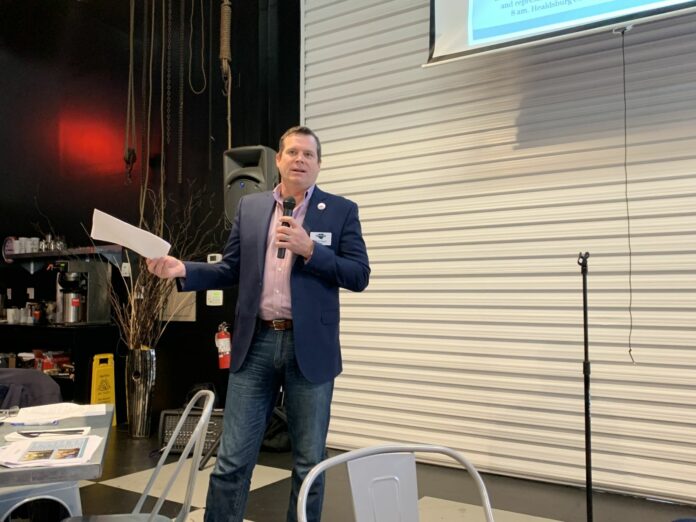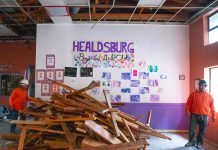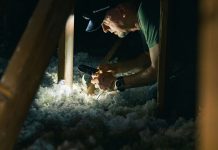
The state of the city of Healdsburg seems to have good footing, however there is room for improvement in regards to affordable housing, community and park connectivity, at least as reported by Mayor David Hagele during his State of the City address Feb. 14 at the Healdsburg Chamber of Commerce breakfast.
Decked out in a salmon pink shirt for Valentine’s Day, Hagele spoke to a large crowd of community and chamber of commerce members at Coyote Sonoma, where he spoke of the city’s strengths: finance, transparency and city worker pensions, and weaknesses where there is room for improvement: housing and connectivity.
Also in attendance were Vice Mayor Leah Gold, the newest elected councilmember, Evelyn Mitchell and former councilmember Gary Plass.
Hagele started his address by saying, “The city of Healdsburg is in pretty good shape.”
“Revenues overall are performing as projected, the city is nearly fully staffed for efficiency as we move full speed ahead on various projects from public works to community services,” Hagele said.
Attendees sipped coffee while Hagele dove into the five talking points of his speech.
Finance
Hagele prefaced his talk on finance by recognizing previous council’s work in setting up the city for a solid financial future.
“We are continuing to meet the reserve policies of our various funds and that is important,” he said.
He continued by saying everyone may not understand that these things were set up by previous councils and that choices made in the past have a big impact on today and in the future.
“That is part why I acknowledge former councilmembers because decisions that were made way back when are having a direct impact on the decisions that we are making,” he said. “When we look at our budget, we just had our mid-year budget review, and I see some of the tweaks where they made to the reserve type of expenses, and it is those things that make Healdsburg stronger financially compared to a lot of the other cities. When you talk with other cities at league of cities meetings, you hear of the struggles or the budget issues they are having.”
Despite reports of a solid financial ground now, he said the city is still aware of what the future may bring in terms of an economic downturn.
“We are coming off the longest economic cycle we’ve had in quite awhile since the last downturn and employment levels in Sonoma County are at historic lows, however, housing availability is very tight and while Sonoma County’s economy is booming the global economy is slowing down and we may face and economic downturn in the near future. So when we look at the city budget and when we’re analyzing, all of that is in the back of our heads to make sure that when the next downturn hits, we are prepared.”
According to the mid-year budget review, sales tax is down 2 percent in the last fiscal year and transfer tax is down 28 percent.
He also added that that more and more people are retiring from the city and in the private sector.
“We are noticing these things and we are going to keep an eye on them,” Hagele said.
Transparency
“One of the biggest successes I think we’ve had is transparency,” Hagele said.
The city now has live and on-demand video of council, planning commission and other meetings that people can watch in real time or at their leisure.
“The beauty of having this online is people get to see ‘how the sausage is made.’ You can see the process, the discussion and the staff presentations,” he added.
In a recent effort to improve transparency, the city has also expanded their social media outreach to Facebook, Nextdoor and Instagram to push information such as meeting agendas and to make them more readily available and easily accessible for residents.
Community conversation events, like coffee with the city, are also starting up. These free events are typically held at the senior center and give residents a chance to speak with councilmembers and ask questions in a comfortable setting.
Speaking of a comfortable setting to share feedback and thoughts, Hagele said, “We’ve also tried to make a more welcoming atmosphere at council meetings.”
At the Feb. 4 city council meeting, residents at an apartment building were voicing concerns over a notice to vacate as a result of the property changing ownership. Many of the residents were Spanish-speaking families. In order to help facilitate public comment, a Spanish-speaking translator was brought in so everyone could have a chance to speak.
Hagele added that he also keeps coloring books in his desk so the meetings are more family friendly.
“I want to make it more welcoming for families,” he said.
Pensions
Another item that is a focus area for the city is finding a smart way to handle pensions.
While Hagele said the city is pretty limited on what they can do, he once again credited former councils and their work on reorganizing pension monies.
In 2015 Healdsburg established its own pension stabilization fund, which according to Hagele, is balanced as of Nov. 30, 2018.
“So we now have a reserve account that we can use as a proof of point toward the general fund,” he said. The city has also been making monthly payments on their pension obligation bonds and once those are paid off they will have more funds available. The city decided to use some of those toward CalPERS, the California Public Employees’ Retirement System, a state agency that manages pension and health benefits.
Affordable housing
Perhaps one of the most perplexing issues for Sonoma County, the Bay Area and the state as a whole, is affordable housing.
According to the SDAT report (Sustainable Design Assessment Team), 11.5 percent of Healdsburg residents have income that allows them to purchase a median-priced home in town. According to the report, this means 562 households earn over $175,000 and can afford a median-priced home – realtor.com statistics show that the median price of sold homes in Healdsburg is at $977,500. A total of 4,309 households cannot afford median-priced homes.
Hagele said of the situation, “To me affordable housing is an economic development issue. If employees do not have a place to live, your business suffers and in turn our community suffers and so there is motivation from the council level to do what we can to help with that situation”
He pointed to the recent opening and ribbon cutting of a 25-unit affordable apartment complex, Healdsburg Glen, and while he said this is progress, it is not the finish line.
“Since 2015 the city has issued building permits for 71 affordable housing units under 120 percent average median income (AMI), 37 of which were under 80 percent AMI. With the addition of Healdsburg Glen, we now have 486 affordable housing units in the city,” Hagele said.
The city also strengthened its inclusionary housing preference to include folks who have lived and worked in Healdsburg or have lived in the Healdsburg ZIP code and last year voters also passed Measure P, which will allow for the construction of more median-income housing.
According to Hagele, Healdsburg is one of 24 cities to have met the needs of the state’s lower to moderate income regional housing needs assessment.
“That is something we can celebrate, however, we look at that more as a mile marker… this is a nation-wide issue and Healdsburg has been a leader on this but we are not done,” Hagele said.
Connectivity
In terms of parks and access points, Hagele said the city is working on connectivity.
“We are working on our redevelopment plan and that will include better river access. We have this great river but we need this easier access to get to it,” he said.
He also said there needs to be improvements to pedestrian path and bike paths.
“We are a small town but it is not easy to bike from Parkland Farms where we live with my daughter. Who put utility poles in the middle of the sidewalk? Apparently we did,” Hagele quipped.
Street studies that are in the works such as the Healdsburg Avenue study will work to see if solutions such as bike lanes or roundabouts can be added to improve connectivity.
In addition, the Foss Creek pathway will start construction from the skate park north behind Big John’s later this year.
Looking ahead the city council will have its goal setting session and will work on its general plan, a living document that sets out the city goals and policies for the next five years.








